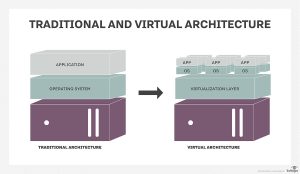Virtualization is a technology that allows from one physical server to create many independent virtual machines. Each virtual machine is a separate system, with its own (virtual) hardware, operating system, and applications.

There are two forms of virtualization:
- Type 1 virtualization: This form of virtualization is run directly on the server’s hardware, for fast processing speed because it is optimized to use server resources. Typical products are VMware’s ESXi, Citrix’s XenServer or Microsoft’s Hyper-V.

- Virtualization Type 2: Virtualization is built on the operating system and software available with popular products such as VMWare Workstation, Microsoft Virtual PC or Oracle VitualBox…

Limitations of the traditional solution:
- High initial cost: when there is a need to deploy a new application or buy more servers, it will be accompanied by other costs such as power source, cooling system, server space, etc.
- Low investment efficiency: with each dedicated server for an application, the utilization rate is only about 5-15%.
- High operating costs: With more and more different servers, different operating systems and applications… will increase the cost of management, monitoring, operation and maintenance.
- Reduced work efficiency: System administrators (IT) will have to focus most of their time on server hardware deployment, configuration, monitoring and maintenance. Therefore, there is not much time left for production and business activities and projects to help improve system infrastructure.
Benefits of Virtualization
Virtualization increases system flexibility, scalability, and significant cost savings. Servers are deployed faster, improving hardware efficiency, and many system management tasks are automated to reduce operating and maintenance costs. Additional benefits include:
- Reduce initial and operating costs.
- Simplify and automate data center management, allowing IT to focus on new applications and services that benefit users and organizations.
- Increases system flexibility, allowing server migration without impacting applications and services running on the servers. Deliver applications and resources faster.
- Minimize or eliminate system downtime for common maintenance tasks: hardware upgrades, operating system updates, software, etc.
- The ability to recover quickly after a disaster.
Types of virtualization
There are six IT areas where virtualization is focusing:
- Network virtualization: is a method of combining and dividing available network bandwidth into independent channels, which can be increased/decreased and allocated to a specific server or device in real time. This idea eliminates the complexity of the network by separating it into manageable parts, like partitioning the hard drive to make it easier to manage files.
- Storage virtualization: is the centralization of physical storage from multiple storage devices into a single storage device that is managed and controlled from a single management interface. Storage virtualization is commonly used in storage networks.
- Server virtualization: is the division of server resources (processor, memory, storage, network communication …) for many independent virtual machines. The goal is to help users avoid knowing and managing the complex details of server resources while enhancing resource sharing and utilization and maintaining scalability in the future. This layer of software is often referred to as a hypervisor.
- Data virtualization: is abstracting the traditional specifications of data and data management, such as location, performance or format, in favor of broader access and good resiliency more closely related to business needs.
- Workstation Virtualization: Virtualization of a workstation (end user’s computer) allows users to access a remote computer through any terminal device (tablet, smartphone or terminal). Virtualized workstations running on servers located in the data center increase flexibility and safety, and reduce management costs.
- Application virtualization: the application layer is separated from the operating system. This way the application can run as a package without being dependent on the underlying operating system. This can allow a Windows application to run on Linux and vice versa.
Virtualization can be seen as part of a broader trend in enterprise IT, including automated computing, a vision where the IT environment can self-manage based on cognitive activity and utility computing, where computer processing rights are seen as a utility that customers only have to pay for when they actually use them. The usual goal of virtualization is to centralize administrative tasks while improving scalability and workloads.

Leave a Reply